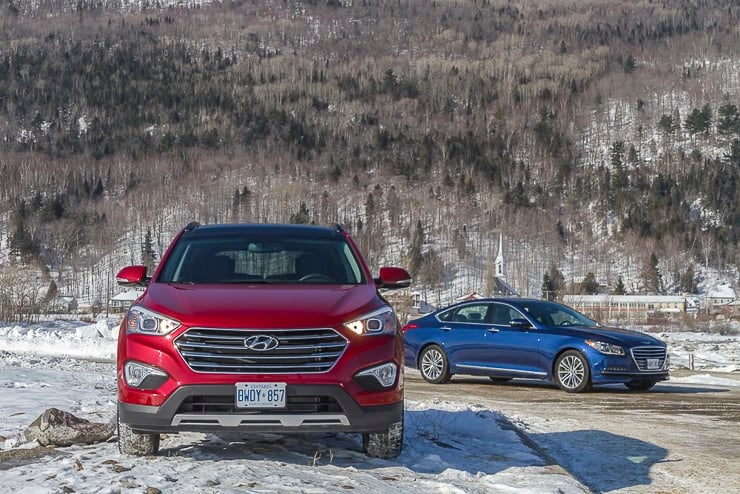Editor’s Note: With the launch of the new 2015 Genesis (reviewed here), Hyundai added HTRAC AWD as standard equipment. This system was designed to deliver performance-enhancing traction on dry roads and driver confidence in wet or winter conditions. The Santa Fe XL is the company’s top-of-the-line SUV and provides seating for up to 7 passengers that depend on an equally adept AWD system.
Baie-Saint-Paul, QC – At some point in the evolution of luxury cars, someone in an automaker’s marketing department realized that a company like Audi (which didn’t introduce its first true SUV until the Q7 arrived in 2007) had been doing it right all along, building a range of “premium” cars with four driven wheels, and promoting the all-wheel drive system (known then, and now, as Quattro) as much as the car it was bolted to.
Now, AWD is offered—if not standard—in upscale cars more often than not, a concept rooted in the idea that increased traction is as much a luxury in a car (as opposed to a crossover or SUV) as any comfort or convenience feature.
All-wheel drive Hyundai models to keep up with the premium offerings
Today, even value-driven Hyundai is in the business of selling luxury cars, and its second-generation Genesis is a fine example of just how important all-wheel drive is in a vehicle intended for upscale buyers. Where the first Genesis’ major failing was its lack of AWD, even as an option, the new one is remarkable for including it as standard in Canada, giving this redesigned car the mechanical credentials to compete with the BMW 5 Series, Mercedes-Benz E-Class and, yes, the quattro-powered Audi A6.
Hyundai specifically names these cars as competition for its Genesis, made by brands from whom this Korean company is very keen on stealing sales.
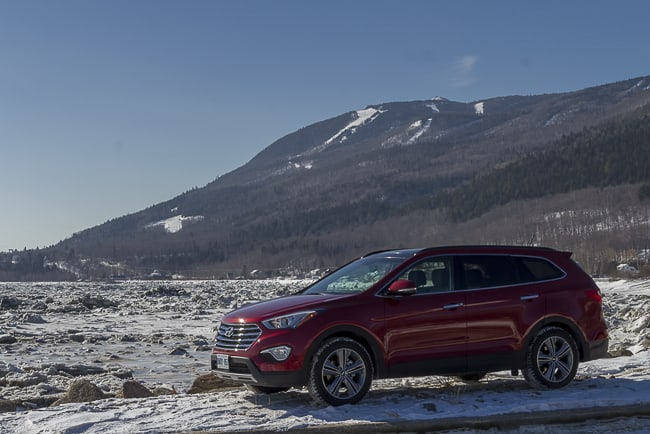
All-wheel drive is mainly promoted for the confidence it adds on slippery roads but in my view, a powerful, upscale car benefits from it in all driving conditions. Late last summer I tested the Kia K900, a large RWD-only sedan based on the Hyundai Equus, whose tendency to spin a rear wheel in quick takeoffs was a turnoff in a car that otherwise was a model of refinement.
Driving purists will say that rear-wheel drive is the ideal arrangement, tasking the back wheels with moving the car, and the fronts with steering it. They’re not wrong, but they’re also not the majority of people who buy luxury cars, and the majority, it seems, wants little more than the effortless performance and foul-weather confidence that all-wheel drive brings.
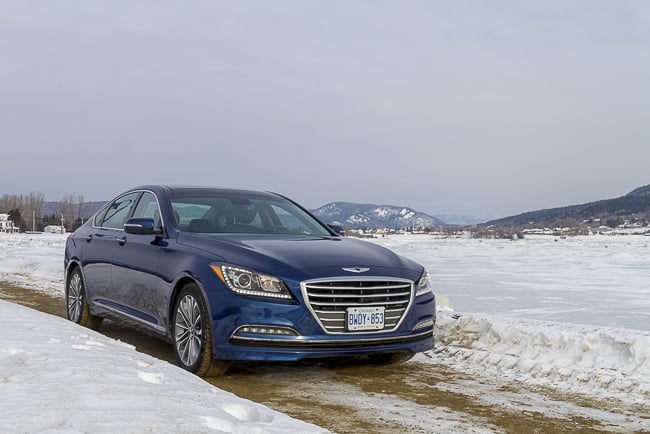
Only Canadian-market Genesis models come standard with AWD; in the US, it’s an option with the base V6 motor, and not offered at all in the top-trim V8 model. Hyundai’s not alone in doing things this way: in Canada, most drivers who shop AWD vehicles (upscale or not) ostensibly do so for the promise of added traction in winter weather.
Any carmaker will tell you their AWD system is better than the rest, and so Hyundai presents the case for the Genesis’ HTRAC setup, which sends all of the engine’s power to the rear wheels at cruising speeds, but diverts 40 percent to the front wheels under acceleration, and can route all but 10 percent to the front in extreme low traction situations.
To help prove their point, Hyundai Canada gave us the opportunity to drive the Genesis and its other premium AWD vehicle, the Santa Fe XL crossover, in some of the wintriest conditions the company could have asked for: on the hilly roads in the Charlevoix region, just east of Quebec City.
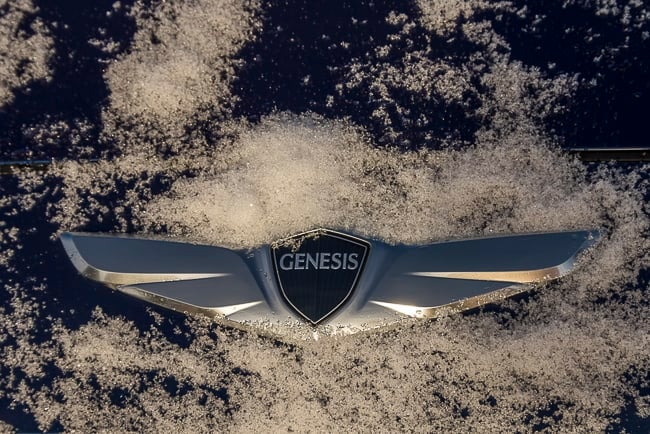
Many of the highways that connect the towns around here are two-lane roads with alternating passing lanes. It’s a road design I’ve always found a bit disconcerting, at least when faced with two lanes of oncoming drivers, the closest of which are usually moving very quickly to get past more leisurely ones while they have the chance.
Compounding that is an ever-changing level of grip: on this part of the drive, we saw clear wet pavement, total snow cover, and a mix of both plus heavy slush. And yet, the locals are driving these routes like it’s a summer afternoon, at speeds between 90 and 110 km/h.
How did the Genesis AWD and Santa Fe AWD perform?
The Genesis has no problem keeping up and feels reasonably safe and secure, but its wide tires occasionally ride up on the snow and slush instead of digging to add traction through it the way narrower rubber would. That’s where you see the downside of a car with performance intentions in winter’s worst.
In contrast to the Genesis, the Santa Fe runs as a front-driver in fair conditions, and uses a multi-plate clutch to power the rear axle when the front wheels spin. It’s a bit less sophisticated, but in throwing both cars around a snowy handling course, the big Santa Fe is just as eager to do a tail-out power slide as the more performance-oriented Genesis.
We spent most of our time in Santa Fe plying smaller roads covered in a few inches of fresh snow. The Santa Fe’s tires aren’t much narrower than those on the Genesis, but this crossover’s extra weight makes it feel more planted and seems to improve grip, particularly on the long, steep downhill stretches that require constant brake pressure to maintain speed—and control.
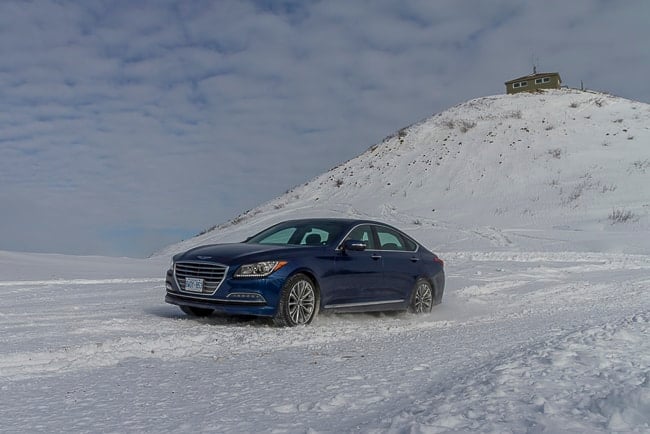
Some of the more advanced features built into the Genesis and Santa Fe’s AWD systems are less obvious on snow and ice than clear roads, where active cornering control (ACC) applies the brakes on the inside rear wheel to improve grip and handling while accelerating through a corner. Acura’s SH-AWD arrangement, for example, is niftier in that it adds power to the outside rear wheel in the same situation, but either way, the goal is the elimination of understeer, which is the opposite of fun in a fast corner.
Despite our contention that the best car to drive in snow is the one that handles better on dry pavement (the Genesis, in this case), it was the big Santa Fe that impressed us with a sure-footedness that belied its mass and size.
The technical stuff is all fine and well, but what really matters to the driver who just ponied up the cash for an upscale all-wheel drive car is that it can handle bad weather better than its rear-drive counterparts. Even a basic knowledge of physics says that will be the case, but again, to drive the message home, Hyundai sent us out on the same course in a first-generation (rear-drive) Genesis, got hopelessly stuck on an icy patch, and needed help of three people pushing to get the back tires onto a grippier surface.
When you’ve paid the extra money for a fancy car, no matter who makes it, it should do most things better than a less-expensive vehicle, including being able to get itself out of a slippery mess—and that’s
why AWD has become one of the most important features offered in most modern luxury cars.

